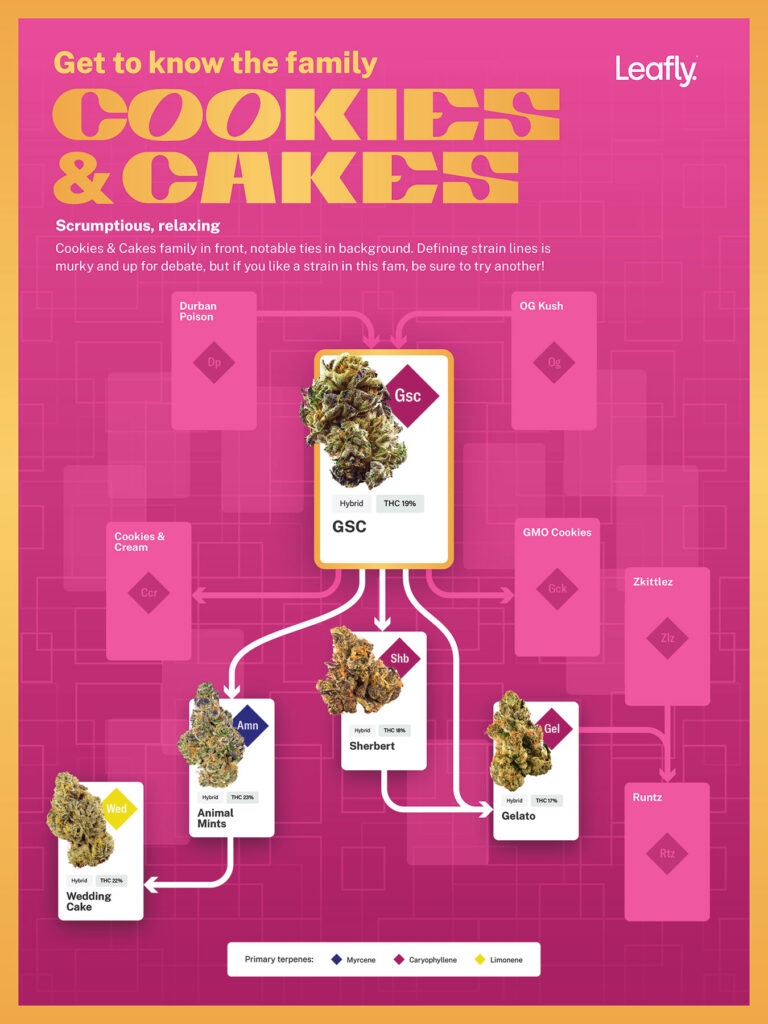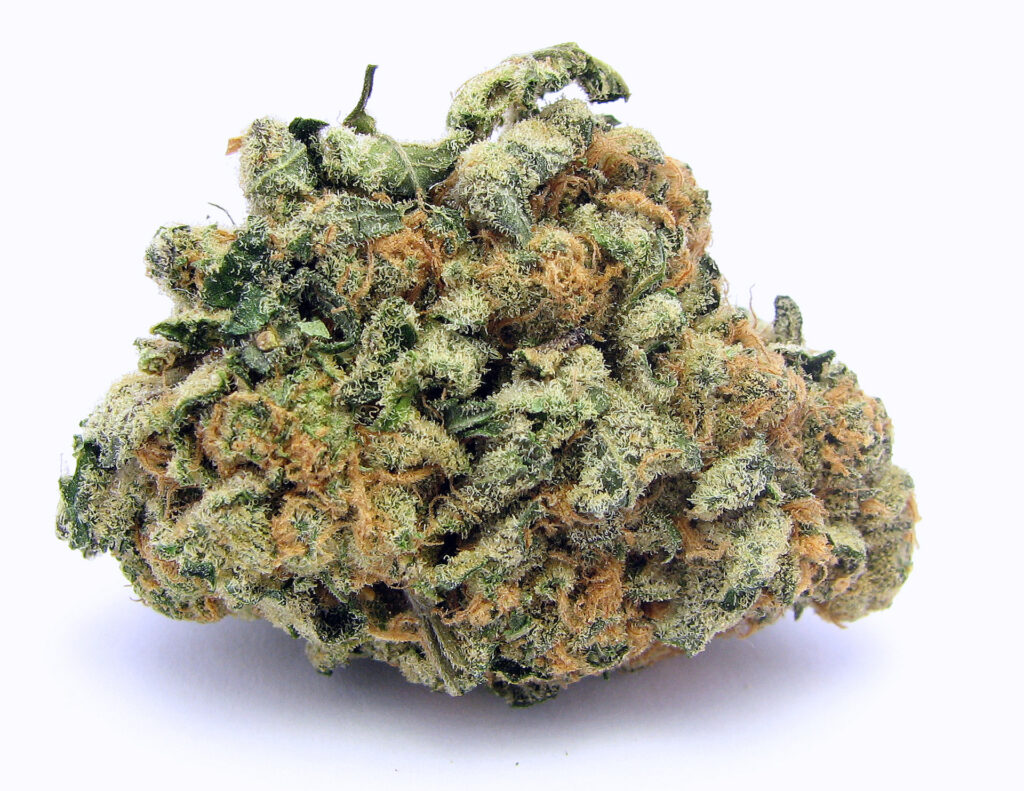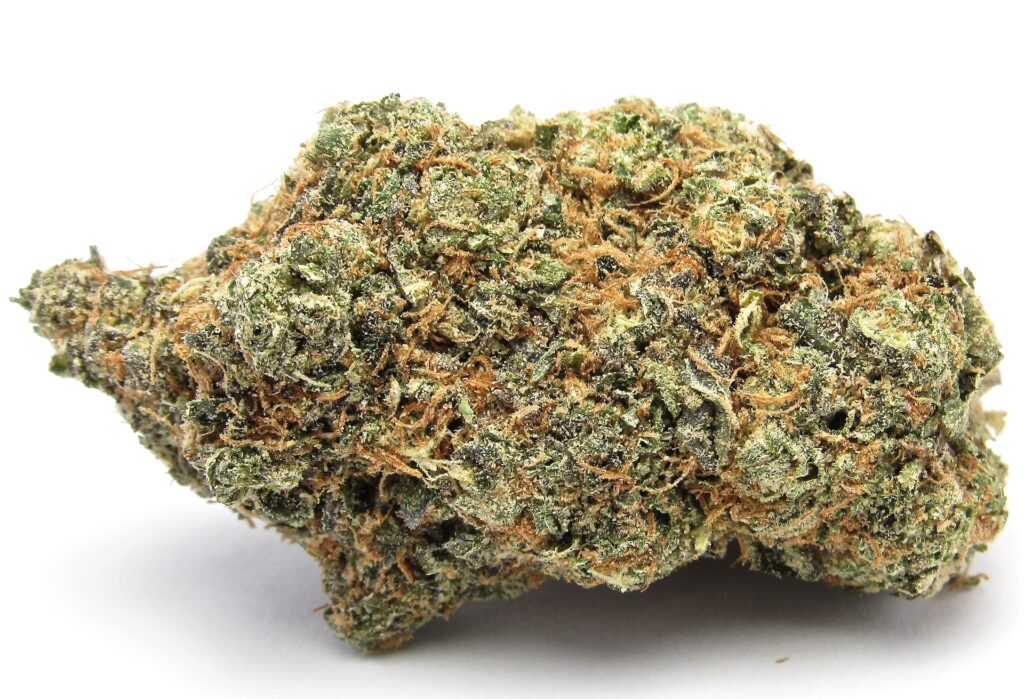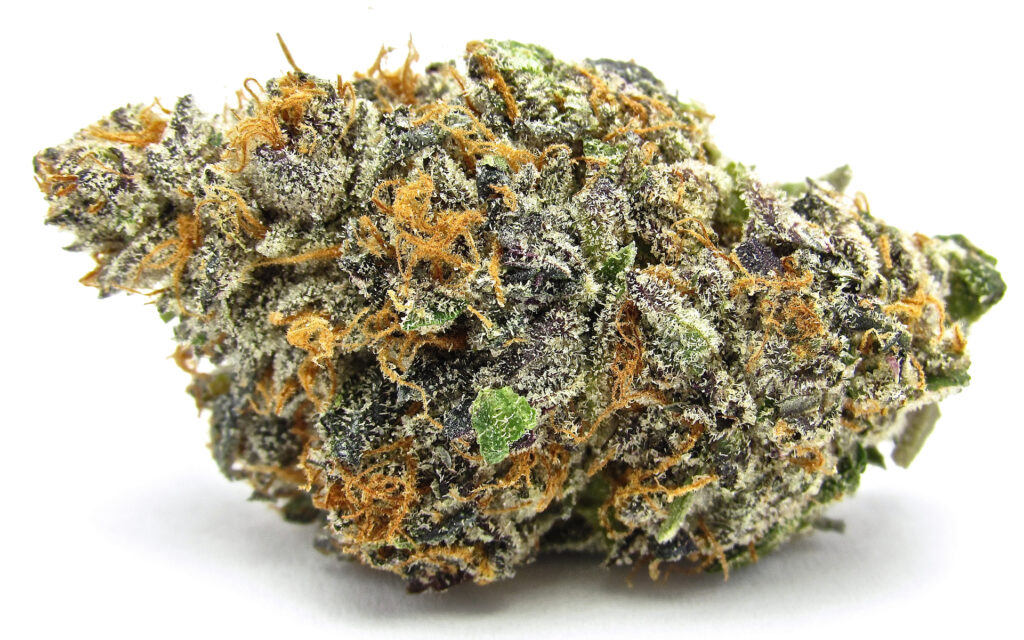[ad_1]
Leafly honors the 50th anniversary of “4:20” (aka “420” or 4/20) this April with a celebration of legendary strain families. We’ve already covered famous Hazes, Tangies, Purples, and OG Kushes. Now for the headliner: Cookies and Cakes!
Why do people wait two hours in line to spend $70 on an eighth-ounce of weed—in the middle of a pandemic?
Easy: the Cookies strain of cannabis transcends mere genetics—it’s a lifestyle.
On November 4, cannabis brand Cookies’ new Apples and Bananas release drew several hundred young, heavy-THC smokers to Berners on Haight in San Francisco. In less than 90 minutes, guys in crisp, white sneakers and basketball shorts bought up all the pricey, designer weed.
They Instagrammed the chic bags of chunky, fragrant, mega-potent bud, flexing on their friends. One group couldn’t wait to get home. They ripped bongloads out the side seats of a dusty, parked Hyundai with no hubcaps.
Cookies and Cakes strains of cannabis—including Sunset Sherbert, Gelato, Runtz, Wedding Cake, and GMO Cookies—comprise modern pot’s center of gravity. Thin Mint Cookies, Animal Cookies, Platinum Cookies, and on and on—they are the top-selling cultivars in legal stores today, and their genes appear in the lion’s share of hyped new weed varieties.
From 2007 to the present—and emanating out of the San Francisco Bay Area—Cookies’ hard-hitting, hybrid indica power, and its complex, sweet- scrumptious aroma has made fans of elite pot snobs, medical marijuana patients with PTSD, all-star rappers, and now almost everyone who partakes.
Cookies got this way because breeders like Jai “Jigga” Chang and Mario “Mr. Sherbinski” Guzman hybridized the best of the early 2000s OG Kushes to some truly exotic sativas. They carved up a wave of medical marijuana and adult-use legalization with rapper/business mogul Berner and wrote the playbook for viral weed marketing.
The Cookies story spans the recent histories of cannabis, weed law reform, San Francisco, and hip-hop. It’s a story of plant worship and profit-chasing, of the serendipity of city life, and the power of sharing gifts, instead of hoarding them.
Grower Ghost at ABF Genetics, short for “Always Be Flowering,” and spreader of Forum Cut Cookies said, growing Cookies “is something that changed my life.”
“It became that thing,” he said. “I challenge people to say what since Cookies—or that was not derived through that whole gene pool—has really changed cannabis.”

The mid-2000s: Jigga makes GSC
Haters gonna hate, but the future still happens first in San Francisco.
So it went with weed strain Girl Scout Cookies, which San Francisco breeder Jigga developed for the exploding medical marijuana market in the late 2000s.
In SF, peak prohibition met surging demand for cannabis and prices bloomed. California’s police arrested smokers by the tens of thousands per year. Growers used pseudonyms only, and feared being followed home from a party and beaten and robbed, or followed home from the hydroponics store and raided by police.
Californians legalized medical marijuana in 1996, and personal defenses against cannabis prosecution had become collective defenses—green-lighting the first dispensaries, and more grows.
“There was this feeling of energy in the Bay Area that there was something going on that was truly special.”
Mr. Sherbinski
The profits outweighed the risk. The Bay Area’s medical and recreational consumers, including its rappers, adored weed. In that climate, wholesale pounds of OG Kush, the then-reigning champion strain, might go for $3,500-4,000.
“There was this feeling of energy in the Bay Area that there was something going on that was truly special,” said Mr. Sherbinski. “An industry was being born.”
“Just like so many other things—music, or technology—cannabis also had its first place there,” he said.
Today most states have medical laws, and 18 have adult-use legalization, now including New York, Virginia, and New Mexico. The legal industry generates $18.3 billion and employs 321,000.
Improving on an OG Kush
Mr. Sherbinski relates how San Francisco breeder Jigga took his favorite OG Kush, called a Flo Rida OG (pronounced “Flow Rider”), and crossed it to his mix of a rocket-like sativa he named “F1” and another strain called “Durb.”
Mr. Sherbinski told Leafly “Durb” was not Durban Poison.
“I’ve had the F1. And I’ve had the Durb. And I’ve had the Flo Rida OG,” said Sherbisnki.
(In 2014, Jigga told High Times that “Durb” was in fact “Durban Poison.” Bottom line: Jigga crossed three strains, “F1 Durb” to Flo Rida OG, to make Cookies.)
Jigga stayed busy, too. He also crossed the F1 Durb to another leader of the day, Granddaddy Purple, thus creating Cherry Pie.
Other, more apocryphal origin stories exist, but “what happens is there’s little pieces of info that get out and people build on that,” said Sherbinski. The above facts are “what I was told by Jigga.”
Jigga didn’t call us back, but either way, Cookies became a sleeper hit.
“And I remember grinding it up and smoking it and thinking, ‘Wow, it’s a super-unique, tasty flower.’ And I said, ‘Yeah, I gotta track down the cut.’”
Ghost, ABF Genetics
Ghost at ABF Genetics said he got introduced to the strain through a friend from Jigga and Sherbinski’s Sunset District clique. (Many of these guys grew up together, going to the same high schools, playing pick-up basketball, smoking weed, listening to rap.)
The veteran grower from back East had collected many, many leading strains. But he still remembers the day his buddy from the Cookies circle brought over a nug of GSC, in about 2008:
“It was like curled up in a Ziploc baggy, this little, abused piece of flower,” Ghost said. “And I remember grinding it up and smoking it and thinking, ‘Wow, it’s a super-unique, tasty flower.’ And I said, ‘Yeah, I gotta track down the cut.’”
Your reporter has been sampling Cookies since that time period, as well.
Cookies nugs present as dense, multicolored, and resinous. It first smells flat and musty, but complex. Break it up and grind it and the smell decoheres into a rowdy mix of sweet, berry, incense, and the savory, burnt part of a sugar cookie. The exhaled smoke hit might contain a note of grape and fuel or “gas” from the OG.
You get real high with a heavy effect that doesn’t make you fall asleep per se—you’re just super-lit.
Berner markets Cookies to Cali
Ghost couldn’t get a cut of Cookies that easily. Back then, growers kept new strains to themselves or in a tight circle.
Initial supplies of Cookies remained low, limited to small indoor grows sometimes shielded from police by a medical marijuana defense.
San Francisco rapper and entrepreneur Gilbert “Berner” Milam Jr. gets credit for truly marketing Cookies, first through hip-hop and rap, and later through social media. Today, Cookies Enterprises commands a global lifestyle brand with licensed stores, unique strains, and partner farms in several legal states.
“Cookies benefited from the advent of social media and was the first cannabis strain mentioned relentlessly in hip-hop,” said Keith Stephenson, the Oakland, CA owner of Purple Heart Patient Center, reportedly the nation’s oldest black-owned dispensary.
If you wanted Cookies back then, you had to schlep out to The Hemp Center on Geary Ave. in the Sunset—this grungy lounge with a Mos Eisley cantina vibe where Berner sometimes budtended. Your fearless reporter distinctly remembers that one and only visit: Junk piled up in the lobby. The weed equivalent of old barflies stared at you from the corner. I bought a gram of GSC there back around 2013(?), and that nug was fire.
2009: Cookies sees Ghost
Ghost got his hands on one Cookies plant in 2008—when two buddies paid $3,500 for a cut from a relative of a grower in the original circle. Ghost grew out the GSC cutting and verified the result. His friend who first brought him the flower said, “That’s it.”
Cookies got loose into the wild when Ghost shared cuttings of his plant with four close friends. Rare strains become a type of currency among high-end connoisseurs that have everything else. Ghost’s cut would become known as the “Forum Cut,” in reference to the internet forums where they debated it.
“And the next thing I know: One of them is selling cuts to people; one of them is giving them away; one of them is doing giveaways behind, like, dumpsters. And then the rest of them just kind of spread through the network.” One cutting, or clone, made it to the UK, Ghost said.

His wholesale pounds of indoor Cookies fetched $4,000, he said, at places like The Green Door.
At this point, a weed grower might assume fame and riches lie in making something special and being the only person with it. Actually—it’s the opposite.
Supplies stimulate demand, which induces growers, thus increasing supplies, and supporting more demand.
“If we hadn’t got that cut out as much as it did, it wouldn’t have become known as what Cookies is,” said Ghost. “If it’s not available, people can’t see it. If they can’t try it, it doesn’t really exist for them. It’ll just fade and die off.”
“If you were a dispensary back then that didn’t have Cookies, then you weren’t a dispensary,” Mr. Sherbinski said.
Animal Cookies, Thin Mint Cookies, Platinum follow
The perpetual motion machine of growing, marketing, selling, buying, smoking, and enjoying Cookies added more and more people each harvest.
“It was a huge seller for some retailers,” said Stephenson at Purple Heart in Oakland, CA. He started carrying Cookies strains in 2012. “It definitely deserves to be celebrated.”
The core Cookies team released Animal Cookies. There was Thin Mint Cookies. Green Door had Platinum Cookies.
A strain truly arrives when counterfeiting and the “name game” commences, said Mr. Sherbinski. Everyone slapped a name on a cookies cultivar.
“We make the strains and they change the names,” he said.
“At that point, it became a clusterfuck,” said Ghost.
2012: The happy accident of Sunset Sherbert
Nowadays, Cookies offspring Gelato and its descendants run the world. But we wouldn’t be here without the happy accident of Sunset Sherbert.
By 2012, the original Cookies craze was well underway, and San Francisco grower Mario Guzman, now known as Mr. Sherbinsnki stood ready to partake in it.
Out in the residential Sunset District of San Francisco, he had crossed a “dark, dark, dark purple, stringy” sativa Burmese to the best OG Kush around the Bay Area, where pounds sold for $4,200 and $4,300.
Mr. Sherbinksi’s Burmese to Larry OG became his Pink Panties, due to its pink hairs, or pistils on the buds. Pink Panties seeds in hand, he started a crop of seedlings. For research, he stuck one, six-inch baby plant into his special, “flowering” room at his grandma’s house.

Flowering room lights are timed to make the plant bloom, instead of grow. But instead of blooming a female bud that he could study, the Pink Panties matured into a male. Before Guzman noticed, the male Pink Panties pollinated the entire room of Girl Scout Cookies females in the flowering room.
“I didn’t realize it would pollinate in a matter of weeks, but it did. It just took off.”
All of a sudden, that commercial crop of Cookies bud became a research crop of new seeds. And inside one of them? What we call Sunset Sherbert.
Mr. Sherbinski said the name came to him when he first smoked the strain, and it reminded him of Thrifty ice cream rainbow sherbet, an iconic California childhood flavor for decades. He remembered his mom buying him a scoop for about ten cents as a kid when they did laundry.
“It was a really popping strain in the Bay Area. We were promoting it. Rappers were rapping about it.”
Mr. Sherbinski
“When I first smoked Sunset Sherbert I tasted berry, citrus, the lemon, the orange, a little lime, all these different flavors and I was like, ‘Man, this tastes like Sherbert.’”
He then added the District it came from—boom, “Sunset Sherbert.” Sunset Sherbert hits “smooth, sweet, but still enough power in it to hit your lungs,” he said. Everyone likes it, he said, including atypical consumers like women, and older smokers, and especially veterans with PTSD.
Related
Pleased as Purple Punch: A ‘Purps’ family genealogy
The Cookies team applied their marketing formula to Sunset Sherbert and repeated the success of Cookies, Guzman said.
”It was a really popping strain in the Bay Area. We were promoting it. Rappers were rapping about it.”
Mr. Sherbinski spread small-batch, indoor harvests of sherbert around to influential stores across the state—stores like Harborside Health Center in Oakland and The Vapor Room on Haight St.
“Part of what created the hype, for me, was: It was created with love; there was not a lot of it; I made sure to spread it around to the dispensaries and friends doing a good job of getting it out to the public.”
2014: Gelato coats the globe
The Cookie and Sunset Sherbert formula may have reached its most evolved form with Gelato: a cross of Sunset Sherbert and Girl Scout Cookies.
For this one, Jigga and Mr. Sherbinski used a substance called colloidal silver to make a female Sunset Sherbet flower produce pollen, then pollinating a GSC.
The resulting seeds are all female, and the team grew them all out, hunting for the best looking and smelling offspring—called a phenotype. This “pheno-hunt” concluded with a private, invite-only tasting by industry heads on June 16, 2014, at a Cuban food restaurant, said Guzman.
The night’s picks are so famous, the numbers on the side of the flower pots became famous and emerged as the keepers:
- Gelato 25
- Gelato 33 (aka Larry Bird;
- ‘Bacio’ Gelato 41
- Gelato 43
- Gelato 45
- ‘Acai’ Gelato 49

Again—high-quality indoor production, plus on-point influencer marketing, equaled huge demand for the elite plant. And again, rather than hoarding the strain close, Mr. Sherbinski distributed cuts of Gelato 33, sparking a national bumper crop of the stuff.
Ghost uses the word, “saturation.”
“It’s one of those things where it just spun and spun and spun.”
Today, there’s a reason why everything contains Gelato 33 genes: because Gelato grows, looks, and smells, and feels amazing. Its architects stimulated the demand; and provided the supply. They didn’t hoard their fire in a closet. They brought it to others, Prometheus-style, and unlocked weed god mode.
Cookies reigns worldwide—for now

Nowadays, Cookies genes appear in everything. Quality can vary, but it often bests its rivals.
“The strains are over-produced now in California, however, it’s something that people expect to find as a standard variety,” said Stephenson.
Even the cheapest of knockoffs attest to the allure of the real thing. If imitation means flattery, the weed world bows to the Cookies strain family. Look at all the headlines:
- Runtz combined Gelato and Zkittlez to take Leafly’s Strain of the Year 2020.
- Chemdog and Cookies crosses dubbed “GMO Cookies” dominate in flower and extract form, said Ghost.
- Most major breeders have Cookies genes in some part of their 2021 offerings, whether it be Compound Genetics’ Jokerz line, or Exotic Genetix’s Rainbow Chip line, or Cannarado’s Sundae Driver work.
- The strain MAC1 reinvigorates Cookies with a fresh reservoir of sativa genes, similar to how Cookies refreshed OGs.
There’s just so many dimensions to Cookies, a seemingly infinite array of facets, all reflecting off this heavy remix of global genetics. Lemon Tree strains and Zkittlez certainly command attention, but they’re still “fads,” compared to Cookies, said Mr. Sherbinski.
“I think what makes a truly good strain is when people come back to it. It’s such a good strain that even if people get away from it for a while when they come back to it she’s going to be there with open arms.”

A timeline of the Cookies and Cakes strains
- 1996: Californians legalize medical cannabis with Proposition 215, via the work of Dennis Peron, Brownie Mary Rathbun, and others.
- 2003: Dispensaries legalized under the “collective” medical cannabis defense in State Senator Mark Leno’s Senate Bill 420
- ~2007s: SF breeder Jai “Jigga” Chang crosses his proprietary ‘F1 Durb’ to a Flo Rida OG Kush, a type of OG Kush to make Girl Scout Cookies.
- 2008: Grower “Ghost” obtains what will be called Forum Cut Cookies for $3,500, gives away four cuts, spreading Cookies across California and to the UK.
- 2010: Jigga and rapper/businessman Berner start Cookies Enterprises.
- 2012: Sunset Sherbert made by Mr. Sherbinski when a Pink Panties juvenile male accidentally pollinates a roomful of GSC. Colorado and Washington state legalize adult-use cannabis.
- 2013: Sunset Sherbert at medical cannabis clubs fetches $4,000 per wholesale pound. Girl Scout Cookies wins Best Indica at the NorCal Cannabis Cup.
- 2014: Sunset Sherbert reversed to GSC results in Gelato. After a pheno-hunt, selections of Gelato 25, 33, 41, 43, 45, and 49 go into production. Mr. Sherbinski gives away Gelato 33. Thin Mint Cookies wins Best Hybrid of the 2014 NorCal Medical Cannabis Cup.
- 2015: Gelato 33 goes into wide production.
- 2016: Californians pass Proposition 64, legalizing adult-use cannabis. Veganic Platinum Cookies wins Best Hybrid in the NorCal Cannabis Cup.
- 2018: Adult-use sales start in California. Triangle Mints #23 (aka Wedding Cake) wins 1st place Best Hybrid in the SoCal Medical Cannabis Cup. Gelonade (Lemon Tree x Gelato) wins Best Sativa at the NorCal Medical Cannabis Cup.
- 2020: Gelato and Zkittlez cross Runtz wins Leafly Strain of the Year.
- 2021: Compound Genetics sells its Jokerz line of Runtz crosses. Gelonade wins The Emerald Cup 2021 for best indoor flower.
What’s your favorite Cookies cross and why? Comment below.
The latest in Strains & products
By submitting this form, you will be subscribed to news and promotional emails from Leafly and you agree to Leafly’s Terms of Service and Privacy Policy. You can unsubscribe from Leafly email messages anytime.
[ad_2]
Source link








